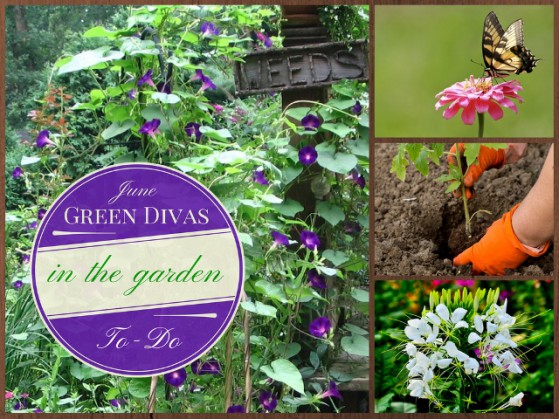Gardening Rebellion: June Gardening To-do’s
{Photo via thegreendivas.com}
Finally, now that the weather is reliably warm, we can move into summer gardening!
It’s safe to plant tropicals and your warm weather vegetables (tomatoes!) and annuals. A little work now with your spring flowering bulbs and shrubs will make more flowers and encourage healthy new growth for next year.
PLANT
Tropicals
It’s safe to plant dahlias, tuberous begonias, caladiums and elephant ears outside in Chicagoland. (Adjust your calendar according to your planting zone.)
Among the tropicals, we plant fragrant moonflowers (ipomoea alba — not datura) with other things, in the containers by the patio, for evening enjoyment, being careful to note that these plants are poisonous. Many of these will be peaking in mid- to late-summer.
We’re also bringing our tropical houseplants outdoors for a summer refresher. Protect houseplants from direct sun and be sure to water well… but check the soil before watering. We’ve had a white mandevilla vine for four years that is an easy keeper and gets more beautiful each year.
Perennials, Grasses, Vines and Shrubs
Choose healthy specimens and be sure to water well when planting and throughout the next year. Grasses planted by early June should have time to get established for bloom this year.
Vegetables and Fruit
Plant tomatoes, pumpkins, melons, beans, cucumbers, peppers, eggplants, squash, sweet corn and okra. When your peas, radishes and lettuce are finished this month, plant something else in that space.
Annuals
There’s still time to plant annuals from seed. We have a lot of very-easy-from-seed annuals like scarlet runner beans, gourds, nasturtiums, zinnias and cleome. Did you know that cleome will grow to be 3-5 feet tall and is a great cut flower for arrangements? It blooms continuously until fall.
Have you noticed that most garden centers are not offering impatiens this year and for the past couple of years? It’s due to a fungal disease called downy mildew. Infected Impatiens walleriana plants can’t recover from the disease, and spores remain in infected soil for years.
My advice is to skip Impatiens walleriana (not the same plant as New Guinea impatiens) completely and use an alternative plant. You might try begonias. For more info, here is a link to a good summary from the Massachusetts Horticultural Society.
HARVEST
Lettuce, arugula, spinach, chive blossoms, Johnny Jump Ups for salads, spring onions, baby carrots, peas, strawberries, asparagus and radishes.
CARE
Post Spring Special Care Notes
Remove yellow foliage of spring flowering bulbs now. Divide spring flowering bulbs early in June.
Shear hedges now, making sure to keep the bottom wider than the top so sun can reach the bottom of the plants. Prune flowering shrubs like lilacs and spring-flowering viburnums that bloom before June 15th (in the Midwest) soon after they bloom to be sure of flowers next year. Pruning promotes new growth, encourages flowering, can help remove dead and/or diseased tissue, maintains size and can control insects and diseases.
Weed vigilantly to maintain control of weeds.
Fertilize by adding compost, if needed.
Water everything that is not receiving sufficient rainfall. Drip irrigation systems are great for this, and soaker hoses are my favorite for perennial beds and vegetable gardens.
Deadhead (remove spent blossoms) to keep plants blooming. Groom plants (remove yellow leaves, broken stems, etc.) to keep everything healthy and looking well. Continue pinching the tips of your hardy mums every two weeks till the 4th of July for optimal mounds full of blooms in the fall. You can also pinch asters in a similar fashion. Stake tall plants.
Continue tying up vines to structures as they grow.
Control Pests/Diseases
Organic gardening best practices focus on using cultural (spacing, crop rotation, pruning and others), mechanical (hand-picking, birdhouses, row covers, sticky traps, and others) and, only as a last resort, natural insecticides to maintain plant health.
Be sure you are using insect and disease controls responsibly and only as needed. Always carefully read and follow label directions when using any pesticide. One of my sources for organic gardening truths is Mother Earth News. Check out this article about organic pest control: what works and what doesn’t.
Make notes in your gardening journal about which plants are doing well and combinations you think work well, which plants might need replacing, and where gaps exist that you might want to fill. You may want to replace winter-burned shrubs with new plantings if, like me, you have those that are beyond salvation.
With the warm weather and all of this to do, take time to enjoy all that is blooming in your garden! Roses are at their best this time of year.
Listen to this Green Divas In The Garden podcast segment for June gardening tips:
*Written by Alison Hoffman for Green Divas. Published with permission.
*****


